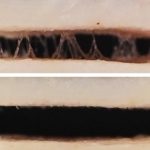Improving adhesives for wearable sensors
Adhesives, including bio-inspired ones that mimic gecko feet and octopus suckers, are not yet practical for mass production. To develop a better alternative, Xi Chen and Tetsushi Taguchi turned to a polymer, poly (vinyl alcohol) (PVA), which is not irritating to the skin and is currently used in some wound dressings, contact lenses and other similar items. Despite its many appealing properties, PVA can come off easily when wet. So, the researchers modified the compound by adding alkyl chains to try to improve its adhesion. They made versions with chains that contained three, six or nine methylene carbons, then tested them to see which performed best. It turned out that films made of longer chain versions were more hydrophobic, but had less tensile strength. Cells best tolerated the short chain known as 4C3-PVA, and in tests with pig skin, they found it bonded most strongly. The researchers conclude that 4C3-PVA is a promising adhesive for wearable devices.
Learn about our two Decals!
 Click here to find out more about our Fall Bioinspired Design Decal and our Spring Bioinspired Design in Action Decal – ALL MAJORS are welcome.
Click here to find out more about our Fall Bioinspired Design Decal and our Spring Bioinspired Design in Action Decal – ALL MAJORS are welcome.Berkeley BioDesign Community
 Click here to learn about the BioD: Bio-Inspired Design @ Berkeley student organization or here to signup for more info.
Click here to learn about the BioD: Bio-Inspired Design @ Berkeley student organization or here to signup for more info.Search
Student Login




I imagine that the neurological circuits underlying these processes are governed by both 2d spacing maps with their brains as…
to reduce the impact of car accidents, it may be possible to study the force diverting physics of cockroaches to…
you see this type of head-bobbing stability in many avian creatures related to pigeons like chickens. the head ability to…
not like they taught horses how to run! this is an example of convergent evolution where both sea creatures and…
The brain functions in a similar way with neuronal connections. our brains are able to utilize the multiplicity of connections…